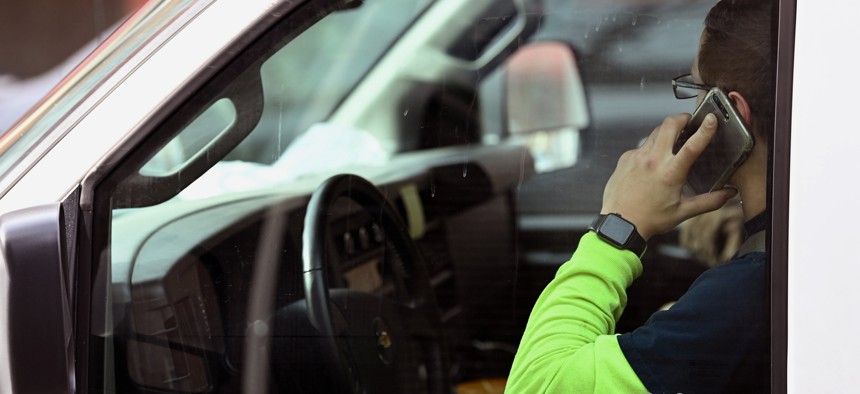Drivers More Distracted Now Than Before the Pandemic, Study Shows

A motorist holds a phone while stopped at a traffic light while driving. Matt McClain/The Washington Post via Getty Images
Data shows that laws to prevent distracted driving have a near-immediate impact, but that the effect wears off quickly.
American drivers have been more distracted by their phones in the last few years, and that appears to have contributed to a recent surge in traffic deaths, according to a new report. But the same group found that state laws to crack down on distracted driving can lead to improvements almost immediately.
The analysis by Cambridge Mobile Telematics, a company that analyzes driver behavior based on data from mobile phones and other internet-enabled devices, concluded that U.S. drivers were 23% more distracted last year than in 2020.
“By almost every metric CMT measures, distracted driving is more present than ever on U.S. roadways,” the company’s analysts wrote. They determined the amount of distraction by using data such as the amount of time drivers interacted with their phones or the amount of time a phone was moving.
“Drivers are spending more time using their phones while driving and doing it on more trips. Drivers interacted with their phones on nearly 58% of trips in 2022, up from 54% in 2020, an 8% rise. Thirty-four percent of phone motion distraction happens above 50 mph, the highest rate in three years. Speeding has increased since 2020, reaching 2 minutes and 14 seconds of every trip,” they said.
The data on distracted driving comes as traffic safety advocates and regulators are scrambling for ways to reduce the number of people who die on or around automobiles. The National Highway Traffic Safety Administration (NHTSA) released estimates last week that road fatalities had decreased slightly from 2021 to 2022, but still remain far higher than before the start of the pandemic.
The agency estimates that 42,795 people died in traffic crashes in 2022. That preliminary number is 144 fewer people than the year before. But it is far higher than the 2019 estimates of 36,355 people who died from vehicles.
“We continue to face a national crisis of traffic deaths on our roadways, and everyone has a role to play in reversing the rise that we experienced in recent years,” said U.S. Transportation Secretary Pete Buttigieg in a statement.
The federal government is still analyzing the factors in the fatal crashes, and NHTSA said it will release more detailed data later this year.
In the meantime, safety advocates have looked to other sources of data, like Cambridge’s, to understand why road deaths are so much higher now than before the pandemic.
In the first year of the Covid-19 outbreak, many people stayed off the roads. Some police departments scaled back enforcement in the wake of mass protests over the police killing of George Floyd in 2020. With less traffic and fewer police to slow them down, many drivers who did go out traveled faster and behaved more recklessly. But even after traffic returned and police stepped up enforcement, the number of road deaths remained stubbornly high.
Safety advocates point to other factors that could be at play, including heavier and more powerful new vehicles, street designs that prioritize motorist speed over pedestrian protection, and the increased prevalence of tech tools integrated into vehicle dashboards that could distract motorists.
“Distracted driving, particularly smartphone screen interaction and phone handling, has long been known to increase cognitive load, impairing drivers’ ability to focus on the road. The Virginia Tech Transportation Institute found that sending or receiving a text message takes a driver’s eyes off the road for an average of 4.6 seconds, equivalent to traveling the length of a football field at 55 mph blindfolded,” the Cambridge analysts wrote.
But the company said states that passed hands-free laws saw significant decreases in distracted driving within a few months. In eight states that passed those laws since 2018, drivers used their phones 13% less within three months of the laws going into effect.
More recently, it reported, Ohio drivers used their phones on the road 8% less in the three weeks since a state ban on using handheld devices while driving took effect April 4.
Some of the effects from new state bans on phone usage are temporary, the company noted. Handheld use actually dropped on average by 16% shortly after new laws took effect in the eight states, but it gradually rose to 13% after three months. By the end of 2022, in fact, phone use in the eight states was 3% higher than it was before the laws took effect.
“We know that [state bans] work in the short term, and they are critically important,” Ryan McMahon, the senior vice president of strategy for CMT, said in a statement. “The challenge is maintaining the gains states make after the bans go into effect.”
Daniel C. Vock is a senior reporter for Route Fifty based in Washington, D.C.
NEXT STORY: Analysis paralysis: When too much data reduces decision-making






